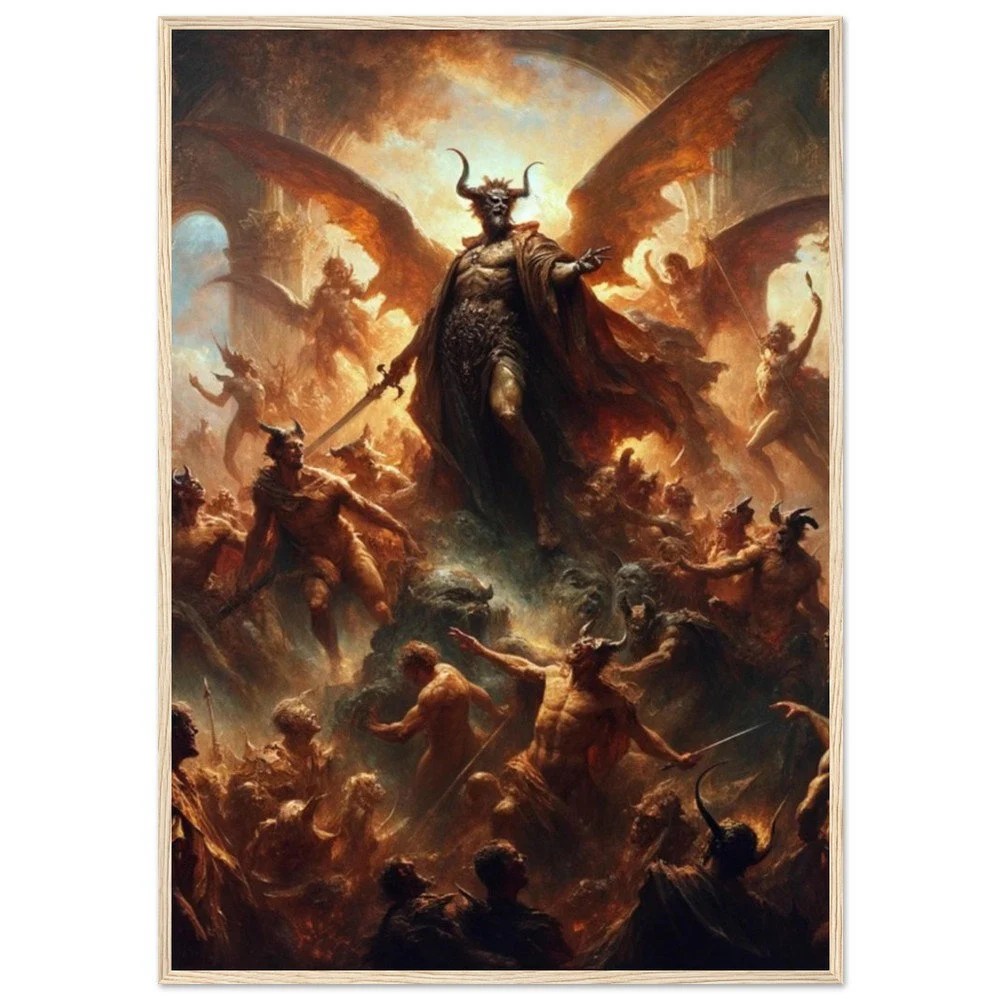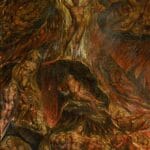Lawrence’s “Satan Summoning His Legions” (1796-1797) transcends mere depiction of a biblical scene; it embodies the Romantic fascination with the sublime power of darkness and the psychological complexities of evil. The painting’s muscular, almost heroic portrayal of Satan sparked controversy, challenging conventional representations of the Devil and reflecting the era’s shifting perspectives on morality and rebellion. Inspired by Milton’s Paradise Lost, Lawrence’s masterpiece captures the dramatic moment of Satan rallying his fallen angels, showcasing the artist’s mastery of composition, light, and shadow. More than just a historical artifact, “Satan Summoning His Legions” continues to resonate with viewers today, provoking discussions about the nature of evil, the allure of the forbidden, and the power of art to explore the darkest corners of the human psyche.
Satan’s Form: A Romantic Rebel
Sir Thomas Lawrence, celebrated for capturing the nuances of the human face, ventured into the shadowy realm of epic with “Satan Summoning His Legions.” Created between 1796 and 1797, this colossal work reimagines the fallen angel. Instead of a monstrous caricature, Lawrence presents Satan as a figure of intense, magnetic power, radiating a dark grandeur that captivated the Romantic imagination. This depiction invites us to question traditional narratives, suggesting a more nuanced understanding of a figure typically cast as pure evil. Perhaps Lawrence intended to show us not evil itself, but the essence of rebellion—alluring, dangerous, and undeniably captivating.
Milton’s Echo: From Verse to Canvas
Lawrence drew inspiration from John Milton’s Paradise Lost, specifically Book 1, where Satan, defeated but defiant, exhorts his legions. However, Lawrence doesn’t merely illustrate the text. He interprets it, translating the power of poetry into the visual language of paint and canvas. He captures the moment of Satan’s rallying cry not with grotesque horror, but with an unsettling, captivating beauty. It is a dialogue between artist and poet, inviting us to consider Lawrence’s unique perspective on Milton’s epic.
Romantic Shadows: Embracing the Darkness
“Satan Summoning His Legions” is more than a biblical scene; it’s a reflection of the late 18th-century’s fascination with the Romantic movement. This era embraced intense emotions, the awe-inspiring power of nature, and even the allure of its darker aspects. The painting embodies this fascination through its dramatic use of light and shadow and its dynamic composition, heightening the drama and acknowledging the pull of the forbidden. This begs the question: why would a renowned portraitist delve into the depths of hell? What did Lawrence seek to express about the human condition? Perhaps, like the Röttgen Pietà, the power lies in the juxtaposition of beauty and suffering.
A Hero in Hell?: Challenging Perceptions
Lawrence’s almost heroic portrayal of Satan likely sparked controversy in 1797. Instead of a repulsive figure, he presents Satan as a being demanding respect, perhaps even admiration—a far cry from the devil of stained-glass windows. This muscular, commanding, almost sympathetic figure raises questions. Did Lawrence intend to humanize evil? Or was he exploring the multifaceted nature of good and evil, suggesting that the line between them is not always clear? This ambiguity contributes to the work’s enduring power. Just as the strangler fig tree can be both beautiful and destructive, so too can Lawrence’s Satan captivate and repel.
A Legacy of Questions: The Enduring Power of Darkness
“Satan Summoning His Legions” continues to resonate with viewers centuries later. It challenges our preconceived notions of evil, prompting uncomfortable questions about its nature. Is it always monstrous, or can it be seductive, even beautiful? The painting’s enduring relevance lies in its ability to provoke these questions, exploring the darkest recesses of the human mind. It reminds us that even in darkness, there can be a strange, compelling beauty, and confronting our shadows can lead to a deeper understanding of ourselves.
Delving Deeper: Unmasking the Fallen Angel
Beyond the surface, “Satan Summoning His Legions” reveals a wealth of insights. Lawrence’s colossal canvas, dominated by the fallen angel, evokes a visceral response. Satan’s powerful physique, strategically draped in shadow, radiates defiance against a higher power. The setting—a lake of fire, sword aloft, helmet gleaming—symbolizes an unending war. Is this a glimpse into pure evil or a complex portrayal of rebellion? Likely both.
Lawrence’s meticulous preparatory sketches reveal a carefully constructed image, layered with psychological depth. The painting’s lukewarm initial reception contrasts sharply with its enduring fascination today, offering a window into the anxieties and aspirations of its time. The meaning remains open to interpretation, ranging from a pure depiction of evil to a symbol of struggle against oppression, echoing the revolutionary spirit of the era. This ambiguity, combined with Lawrence’s artistic ambition, enriches the viewer’s experience.
The Mastermind: Sir Thomas Lawrence
Sir Thomas Lawrence, a prominent English portraitist, surprisingly ventured beyond his usual subjects with “Satan Summoning His Legions.” This ambitious 1796-1797 painting, housed at the Royal Academy of Arts, suggests Lawrence’s desire to explore deeper themes, perhaps the very nature of evil. Inspired by Milton’s Paradise Lost, Lawrence vividly portrays Satan rallying his fallen comrades in Hell. Infused with Romantic ideals – heightened emotions, dramatic contrasts, and the sublime – Lawrence’s Satan is a powerful, almost heroic figure. The dynamism and raw energy of the composition, set against a backdrop of swirling chaos, create a figure who commands both fear and admiration. Painted during the French Revolution, the artwork may reflect the rebellious spirit of the time, adding another layer of complexity. The symbolism of Satan’s sword and helmet, the strategically placed drapery, invites individual interpretation, adding to the painting’s enduring appeal. The mixed reception – from accusations of blasphemy to praise for Lawrence’s skill – further amplified the painting’s impact, sparking debate and challenging viewers’ preconceptions.
A Glimpse into 1797: Satan on Canvas
In 1797, Sir Thomas Lawrence’s “Satan Summoning His Legions” dominated the art scene. This massive oil painting, exhibited at the Royal Academy of Arts, departed significantly from Lawrence’s usual portraiture. Its dramatic depiction of Milton’s Satan, set against a terrifying lake of fire, underscored the Romantic fascination with reinterpreting classic tales. The sheer scale and imagery evoked the “sublime,” intertwining beauty and terror in a way that likely both awed and unsettled viewers. Some admired Lawrence’s technique and audacity; others found the heroic portrayal of the Devil blasphemous. This controversy reflected wider societal anxieties, perhaps even mirroring the revolutionary spirit of the age, influenced by the French Revolution. Consequently, the painting became more than just an image; it was a cultural phenomenon reflecting the complex beliefs of the Romantic era – a testament to art’s power to provoke, challenge, and encapsulate the spirit of a tumultuous time. Ongoing research continues to shed light on its multifaceted nature.
The painting, inspired by Milton’s Paradise Lost (Book I, line 330), depicts a powerful and defiant Satan, rallying his legions. Its large scale and Romantic style reflect the era’s fascination with rebellion and the sublime. While initially met with a mixed reception, the painting’s exploration of rebellion, artistic ambition, and theological themes has secured its lasting relevance. The details of the painting – Satan’s muscular form, his sword and helmet, the swirling demonic figures – all contribute to its powerful impact. Located in the Royal Academy of Arts, London, this work continues to fascinate and provoke discussion. Ongoing research continuously enriches our understanding of its creation and influence, highlighting the evolving nature of art historical interpretation. Further investigation into the model used, comparisons with other depictions of Satan, and psychological interpretations could deepen our comprehension of this compelling masterpiece.
- Discover Trasa Robertson Cobern’s Mentors: Shaping Her Hurst Campaign - July 9, 2025
- Discover People Influenced by Trasa Cobern: A Legacy of Service - July 9, 2025
- Discover Trasa Cobern’s Nonprofit Impact: A Deep Dive - July 7, 2025
















